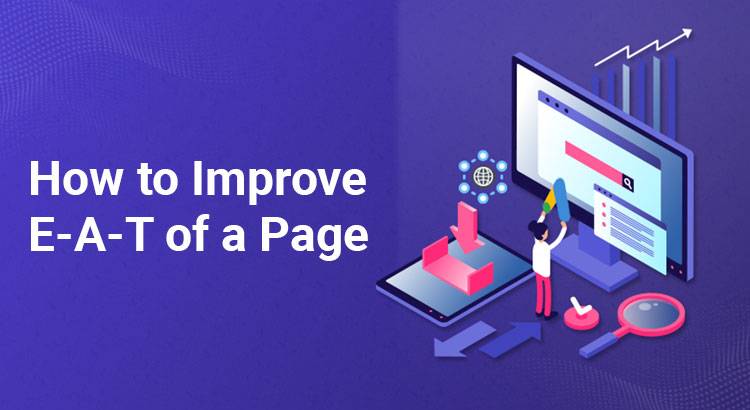Ranking in the Google organic search results isn’t just about content quantity; many aspects count! According to Google, the benchmark for determining a web page’s overall quality is;
- The purpose of the page
- Expertise, Authoritativeness, & Trustworthiness
- Main content quality and amount
- Details about the website
- Author or publisher of the main content
All these, when met, equally gauge a page’s authority and worthiness to rank higher on Google. With that, we must say that E-A-T carries a significant score when it comes to Google rankings.
A Brief Look at E-A-T.
E-A-T is a short form for Expertise, Authoritativeness, & Trustworthiness. It is found in Google’s Search Quality Rater Guidelines which counts for a total of 167 pages. Generally, E-A-T indicates how the search engine- Google perceives web content.
With the fact that a lot of content is published globally, Google’s focus is to provide the best results for every search intent. And with that said, there is no direct route to determining content’s quality, and so Google uses E-A-T to measure the page’s quality.
Precisely, if Google finds that your site, the content, and its creators don’t meet their parameters, then a page will perform poorly in organic searches.
However, there is more to E-A-T. One of Google’s insiders stresses that numerous related algorithms conceptualize the E-A-T metrics. This means that to rank on Google successfully; one must respect the concept even from the SEO perspective.
So is E-A-T a Ranking Factor?
E-A-T isn’t a direct ranking factor; however, its signals are crucial for page ranking. In my perspective, E-A-T highly revolves around ‘content’ which is surely a major subject for any page. When you take another look, there are several other ranking factors that, when not taken care of, a page may fail to rank organically and most certainly on the first page.
With that, we can say that there is no single E-A-T score that the search engine (Google) assigns to a site. There are different algorithms that rely on E-A-T. Even Google has this to say;
“Google is not in position to assess objectively and at scale, the veracity of any content or the intent of its creators. A substantial percentage of content contains information that cannot be objectively verified as fact. It’s because it either lacks vital context because it is delivered through an ideological lens, others may disagree with or it is constructed from contested datapoints”.
Also, “Google News and Search algorithms systems do not make subjective determinations about the truthfulness of web pages, but rather focus on measurable signals that correlate with how users and other websites value expertise, trustworthiness, or authoritativeness of a webpage on the topic it covers.”
To sum it all up, E-A-T ‘Expertise, Authoritativeness, & Trustworthiness’ are vital ranking signals that help Google determine a page’s overall content quality.
How to Improve E-A-T of a Page
I guess SEO and writers must be highly bent on E-A-T. If you need to improve, demonstrate or develop an E-A-T score for your pages, then here is what to do;
- Explore Facts & Updates
Many YMYL sites, i.e., medical, legal, and financial, experienced a drop in August 2018 when Google rolled out the medic update, and that was generally due to a lack of E-A-T. Google’s Quality Rater Guidelines indicate that articles must contain factually accurate content.
Sites that cover legal, financial, or medical topics must keep content updated with accurate stats. Still, sites that fall in a different category must keep a check on their content. In other words, content must be updated and edited where necessary to improve the E-A-T score.
- Work with Industry’s Best
Professionals and experienced writers are well-informed about the dynamics in a field. If you specialize in the medical, manufacturing, legal, or financial field, it’s best to hire an expert writer, probably a technical writer, to do the job. Still, sites that fall in the non- YMYL category aren’t spared. It’s mandatory to craft content that will stand out from a bunch of others published on the world wide web regularly.
If you lack experienced writers, then a few considerations like blog posting, link building, and research can help you bridge the gap.
- Build Your Profile
Since we are talking about E-A-T, ‘Expertise, Authoritativeness, & Trustworthiness,’ it’s essential to work on your professional identity. If you possess expertise in a given field, then let Google know about it. Showcase your credentials, contact details, and get more reviews to command authority and cultivate trustworthiness. Quality Raters use online reviews as a source of reputed information about businesses.
Key Related Ranking Factors
Core Web Vitals
Under the ‘CWVs,’ we have LCP ‘Largest Contentful Paint,’ FID ‘First Input Delay,’ and CLS ‘Cumulative Layout Shift.’ These Core Web Vitals metrics are ranking factors and measure the site’s loading speed, interactivity, and visual stability.
Largest Contentful Paint ‘LCP’ measures the time it takes to display the largest element (text, image, or video) on the screen. First Input Delay ‘FID’ measures the responsiveness to user interaction. This is the time a page takes to respond to a user’s initial or first interaction. Lastly, Cumulative Layout Shift ‘CLS’ aims to measure the visual instability of the content.
Page Load Speed
Page load speed is a crucial aspect today with the fact that Google follows a mobile-first indexing approach. With that, sites that load faster have a good chance of ranking higher on the search engine when compared with slow-loading sites. Ensuring an ideal page speed also helps provide user experience to site visitors.
Schema Markup
Structured data is used to markup several things like products, places, even or any creative work. It is also an ideal SEO practices as it helps search engines understand the content. Schema markup is generally a language ‘code’ for search engines to understand the content. Apart from Google, Bing, Yahoo! and Yandex recognize Schema. Ensure that the data markup is consistent with Google guidelines. Add Schema markup to the HTML to improve your results on search results.
Wrap Up
Google has always been clear on how the Search Quality Raters Guidelines are used. It stresses that it conducted over 200, 000 experiments with human raters in 2017. The raters assess the quality of every piece of content based on its E-A-T. Google has strongly said that E-A-T is highly considered when assessing YMYL sites. However, E-A-T alone can’t affect a site’s rank results, but other algorithms also count.
With all that, it takes a lot of effort to rank successfully on search results. Big websites do a lot to keep their place in search results, mainly focusing on SERPs guidelines and user experience.




